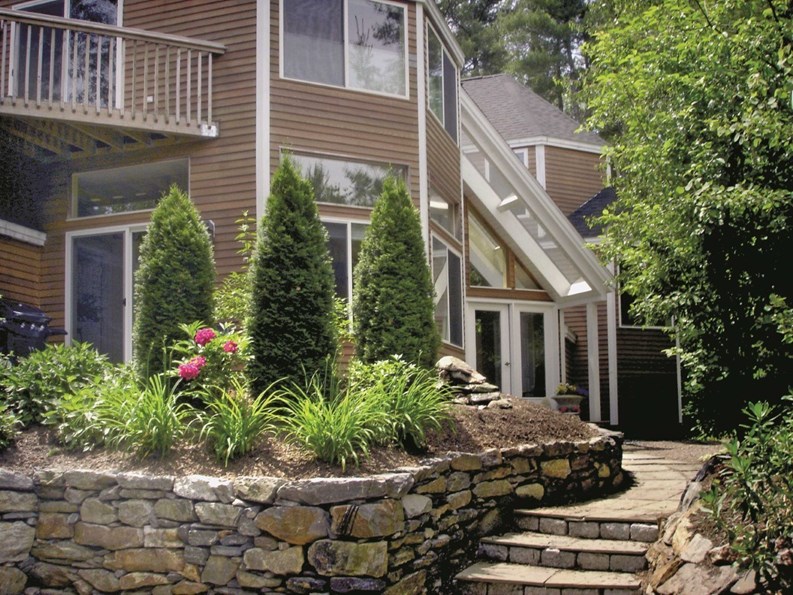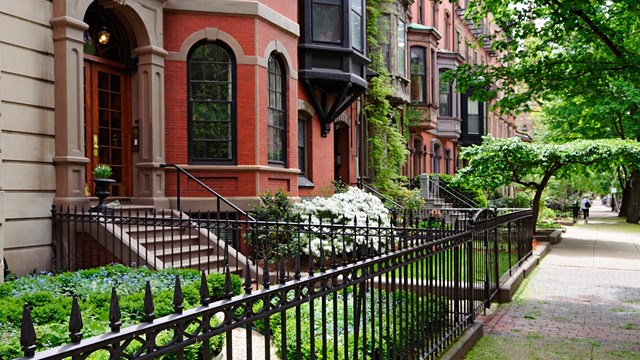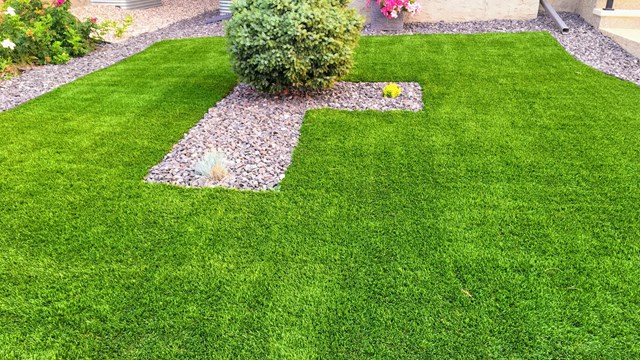As today’s homeowners forego vacations – and long for a getaway without actually going away –the idea of creating that retreat outside the back door is gaining popularity. “People are looking for a place they can enjoy, and not feel that their neighbors are in their space,” says Ellin Hanlon, APLD, owner of Bright Ideas Garden Design in Groton, Massachusetts.
What they’re searching for is a quiet haven. A refreshing oasis. A secret garden. A private retreat.
Do those phrases describe the front entry, the backyard terrace, or the deck of your townhouse or ground-level condominium? Should they?
Jerry Sarno certainly thinks so. “By having a space designed around the way you like to live, your life will be happier and more enjoyable,” says the architect, developer and builder. So when he planned Deer Path Farms in Hudson, Massachusetts, he incorporated his long-held philosophy that homeowners should be involved in the design process from the beginning – for both the interior spaces and the grounds surrounding their “single-family attached townhouses.”
The outdoor spaces, he says, “are designed to the needs and lifestyles of the people living in the home, what they aspire to, and how they like to use the space.” Mounded earth, evergreens and other features create private spacesfor each homeowner.
But the Deer Path Farms philosophyis not necessarily the norm for common-interest communities; most condominium owners have not had a hand in designing their spaces from the start.
The challenges facing common-interest homeowners longing for that private retreat, Hanlon notes, are that “condominiums are all over the place in terms of how much land they have available – and the restrictions on that land.” While a designer can often do wonders with even a small plot of land, any work customizing exterior space around an individual condo has to be in conformity with the association documents.
“The first step,” cautions attorney Frank Flynn, principal of Downing & Flynn in Boston, “is to check the condominium docs, and also the rules and the regulations.” Restrictions can run the gamut from non-existent to extremely specific. “Many condos in Massachusetts have rules and regulations that cover issues like this,” Flynn says. Communities vary in terms of what spaces the unit owner actually owns or controls – and in some communities, the condo backyard may actually be a common area even though a homeowner may think of it as “my space.” Since landscaping plans may involve structural changes, like the installation of fencing, a checkof the condominium documents is absolutely essential.
Hanlon and other design professionals advise owners to look into those restrictions long before building a concept for their dream space. After determining what can, or can’t, be done, it’s time to let the imagination loose.
“Everybody has a wish-list,” says landscape designer Maria von Brincken, APLD, of Sudbury, Massachusetts. “Even if the space is not large, there are ways to create private areas for different functions – for dining, for relaxing, or a place for the grandchildrento play.” A swath of lawn or a small patio can be turned into an inviting, intimate environment through the use of attractive containers, beautiful furniture and great paving materials, she notes.
Personal Experience
Because her own community association had no restrictions, von Brincken was able to “totally transform” the space around her home, including the back yard terrace and deck. Gorgeous plants, seating areas, planters filled with bright flowers can turn a plain plot of land into an extension of a condominium’s living space, she says. Even in New England, the result can be a four-season delight.
Not all condo owners have the free rein that she enjoyed, but a professional landscape designer – easily recognized by an affiliation with the Association of Professional Landscape Designers – will have the “eye” needed to see what can be done within the bounds of association documents. “Everyone has that special ‘wish list’ and a designer can often figure out how to make it work, even in a small space. One key, she notes, is to work with plants that “really perform” in that setting – plants that won’t outgrow the space or requirea lot of maintenance. “They have to be real work-horses,” she says.
It’s all too easy for homeowners to see a cute little tree in a nursery, and not visualize what that tree will look like in five or ten years, adds Hanlon. “When I design, I design with the mature plant in mind; it’s unfair to put in something that in five years will be out of control. It’s critical to put in appropriate plants that are scaled for the kind of area you find in a condominium.”
Ideas are Limitless
It may be hard to imagine that little patio or deck area as a lush garden – but that’s where the professionals come into play. “There are so many interesting ways that space can be maximized,” Hanlon says, “to make the space look larger. With the right privacy screening, you can have a beautiful oasis in a small space… maybe add an arbor, or a water feature. They don’t have to take up a lotof space, but you get all the benefits – water is so soothing – in a backyard.”
Building on a thesis for architecture he developed many years ago, Sarno decided to develop homes in the Deer Path Farms community with owner involvement from the start. “I felt it would be better for people, better for the community, and the value would be greater,” he says. Depending on the home, the outside spaces at Deer Path Farms may be small, or they may covera half-acre, or even an acre of land.
And Deer Path Farms owners can personalize that space to fit their life-styles. While much of that personalization is done when the homes are built – the community currently has about 50 homes, and will grow to about 130 when complete – the homeowners continue to enhance their outdoor spaces as time goes on. “Gardens can be very therapeutic and enjoyable,” Sarno says. The association does have a say about the landscaping. But the board – of which Sarno is chairman – works with owners to help accomplish their goals while maintaining the cohesive appearance of the community.“The association helps with things an owner can’t do; in many cases, the association has done the work gratis because the owner is also enhancing the community,” he says.
An upside to homeowners beautifyingtheir little plot of land, he notes, is that “it becomes contagious. People share seedlings and cuttings.”
Drawing the Line
But that doesn’t mean that “anything goes,” even in a community that encourages a homeowner’s dreams.
The Deer Path Farms board, for example, wasn’t enthusiastic about vegetable gardens around the homes. But recognizing that people are increasingly conscious about the freshness and quality of food, the board developed a private area where vegetables can be grown, without infringing on the appearance of the homes.
Attorney Flynn says he has not seen associations with committees that examine landscaping proposals. At the same time, he adds, “I have not heard much about landscaping being a source of controversy” – although outdoor decorations can become sources of contention.
After all, Hanlon notes, “neighbors also benefit” from well-planned landscaping. “It may make sense in a community to do a collaboration, for a set of homeowners to come together to enhance an area.” Homeowners, she says, should work with the association – and it’s a good idea for the association to regularly assess the community’s common-area landscaping, too, with aneye toward gaining control of plantings that have outgrown their spaces.
Well-done landscaping in both common areas and more private spots within the community add to its curb appeal and property values, von Brincken adds. “If you have attractive landscaping, you enjoy it every time you walk out of your home.”
And, she notes, “Beautiful grounds add to your life.”
Pat Gale is the associate editor at New England Condominium magazine.







Leave a Comment